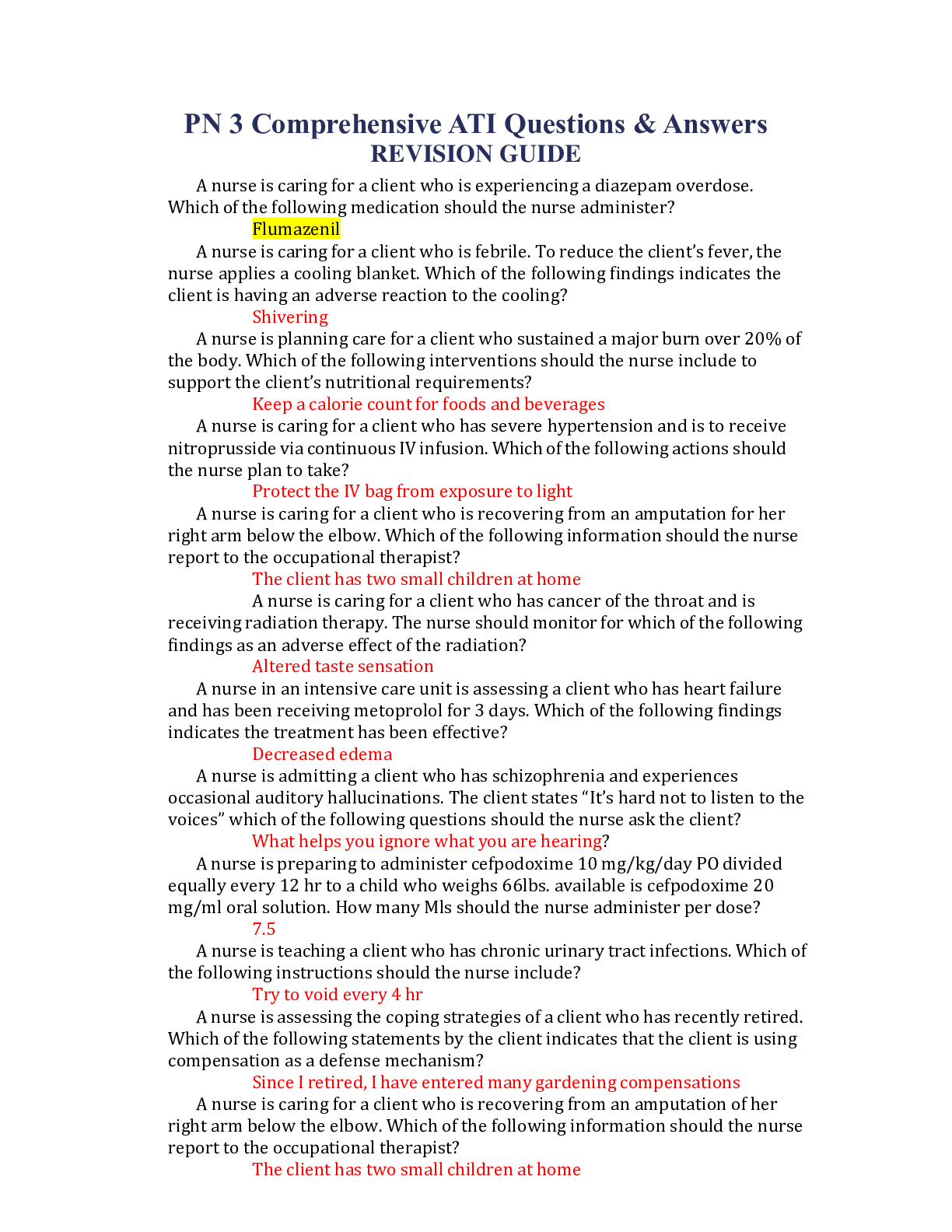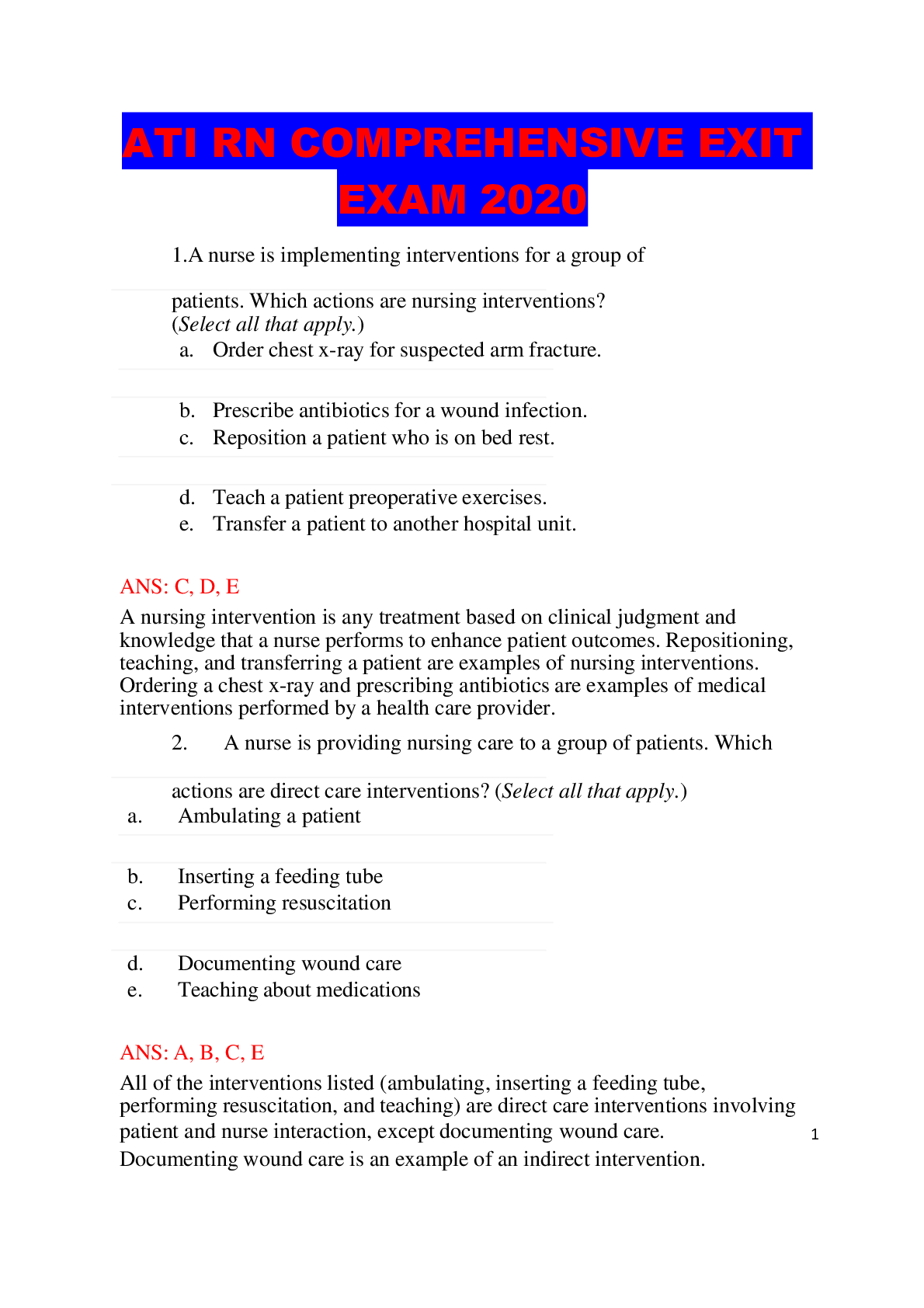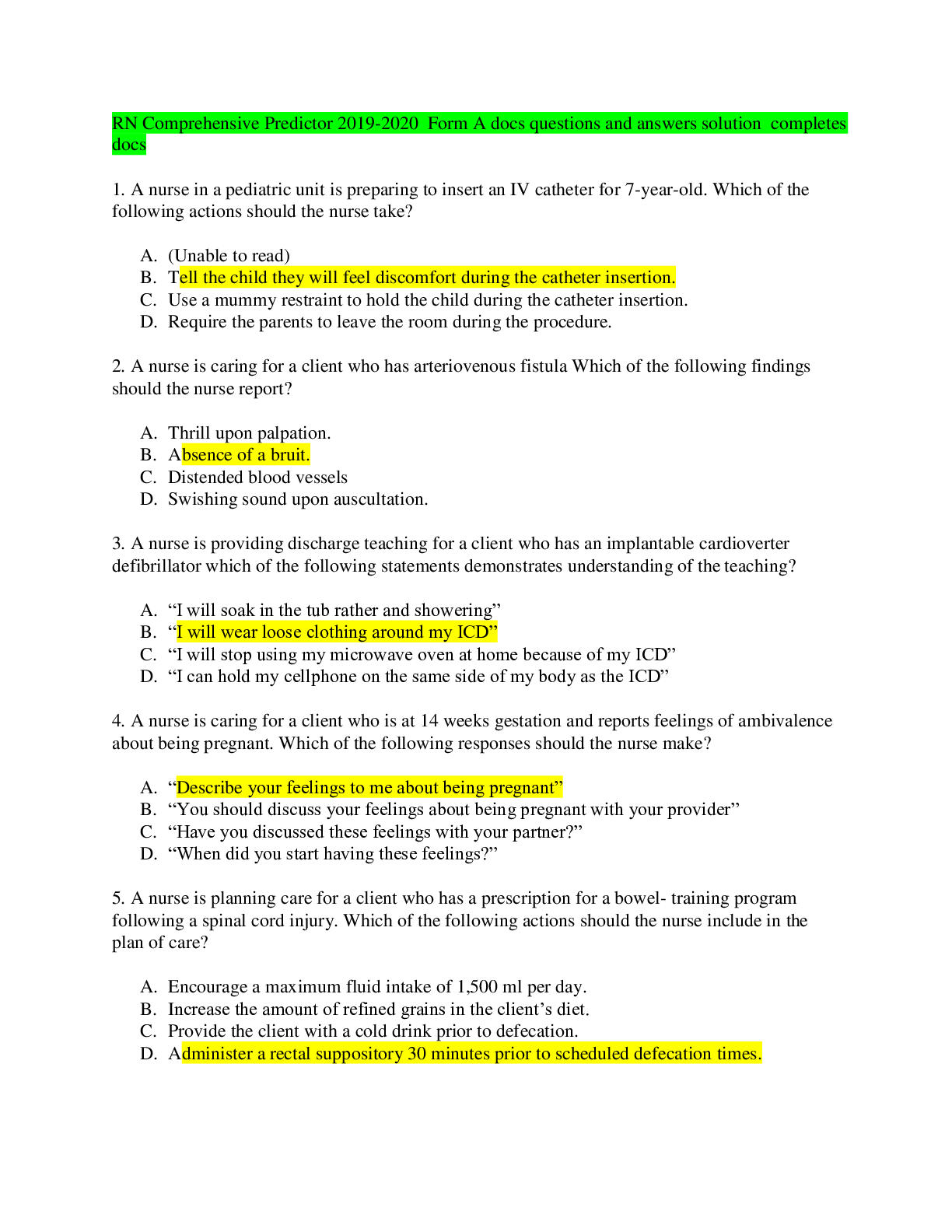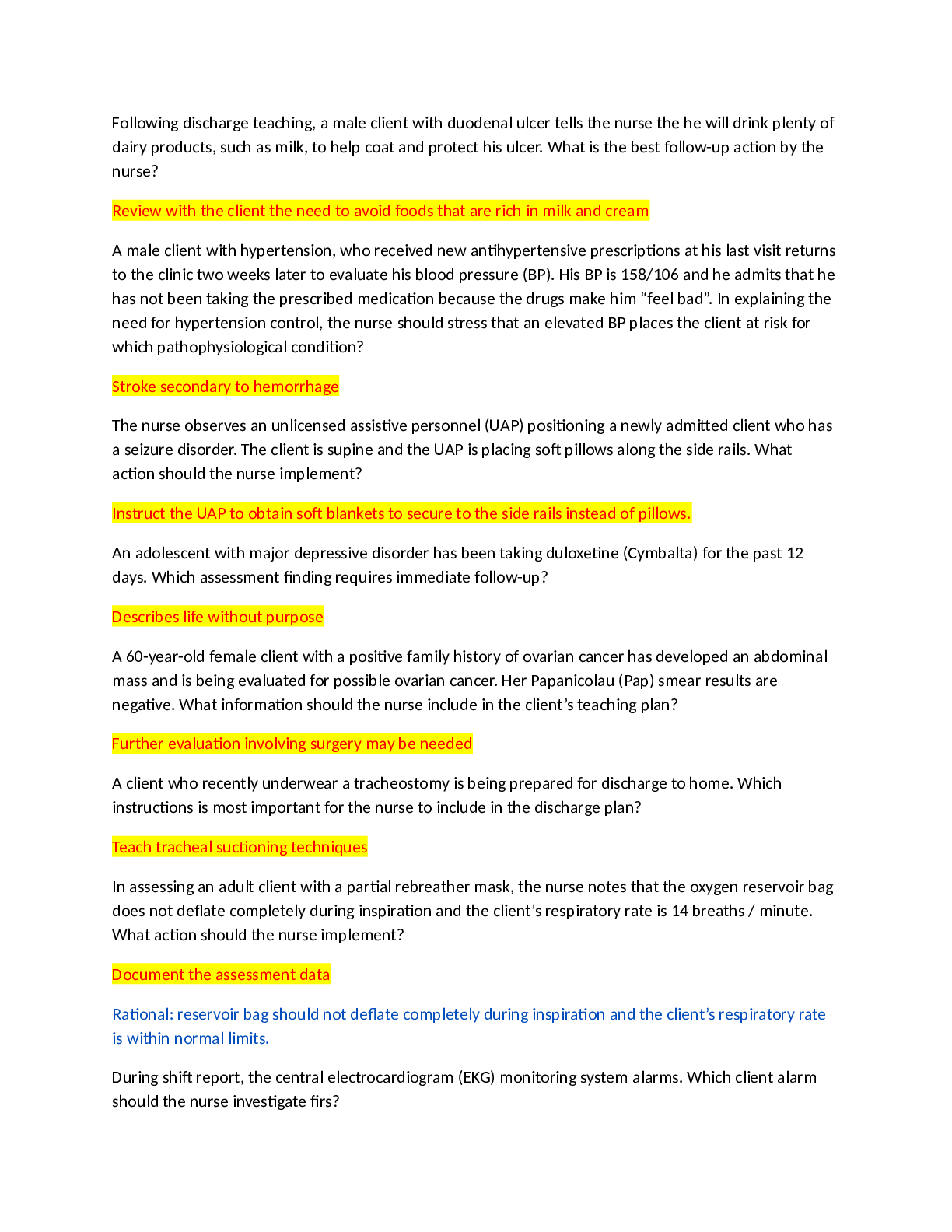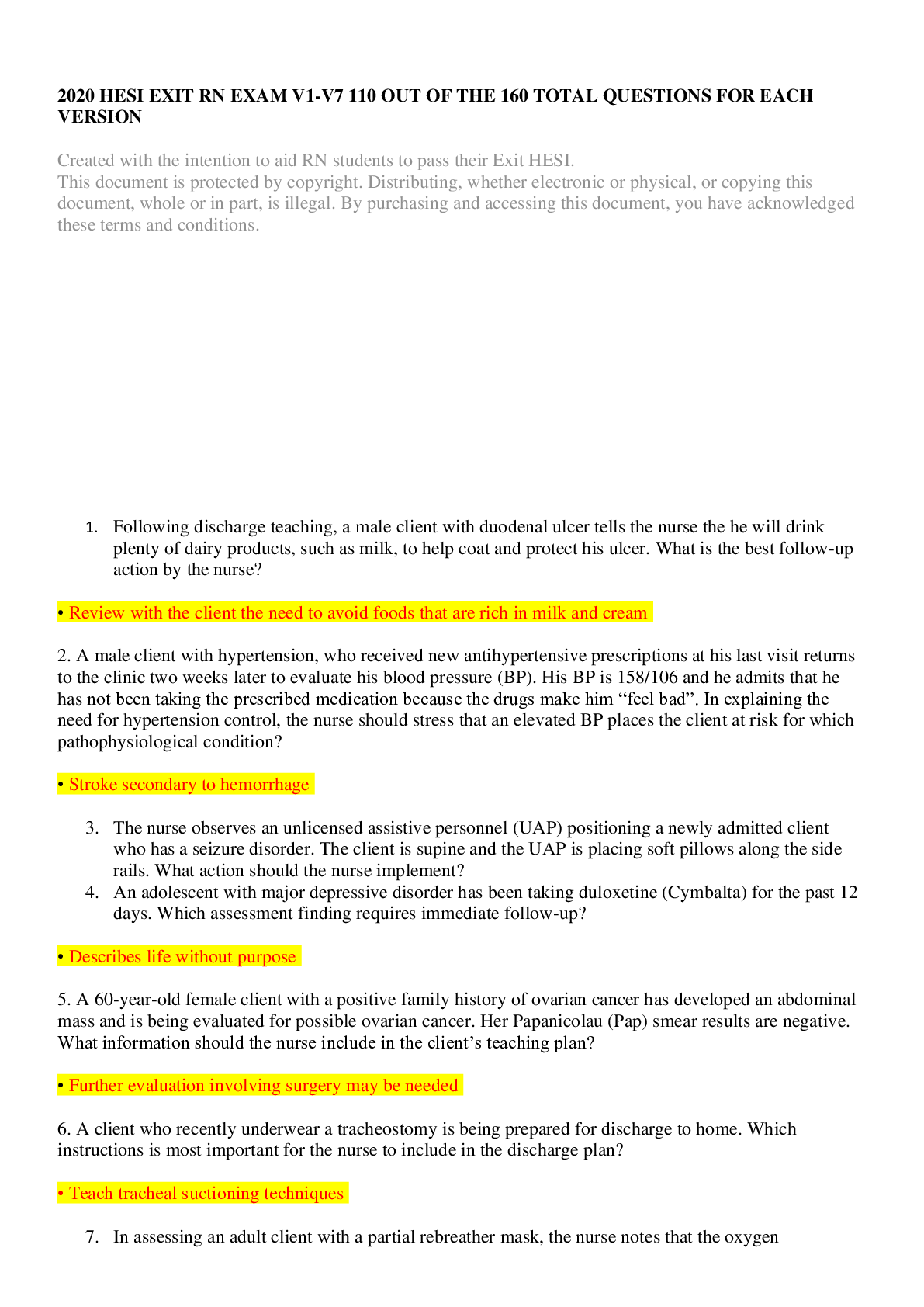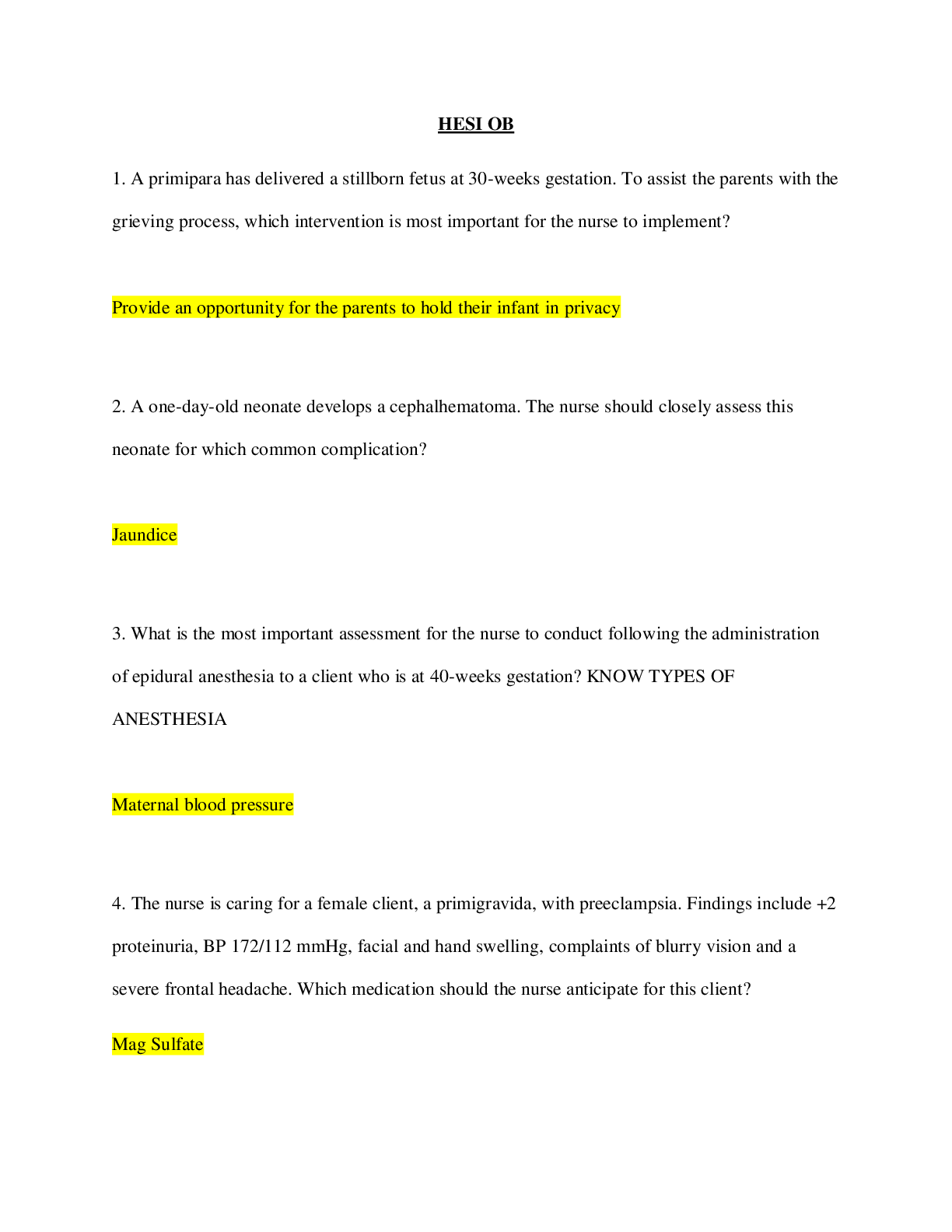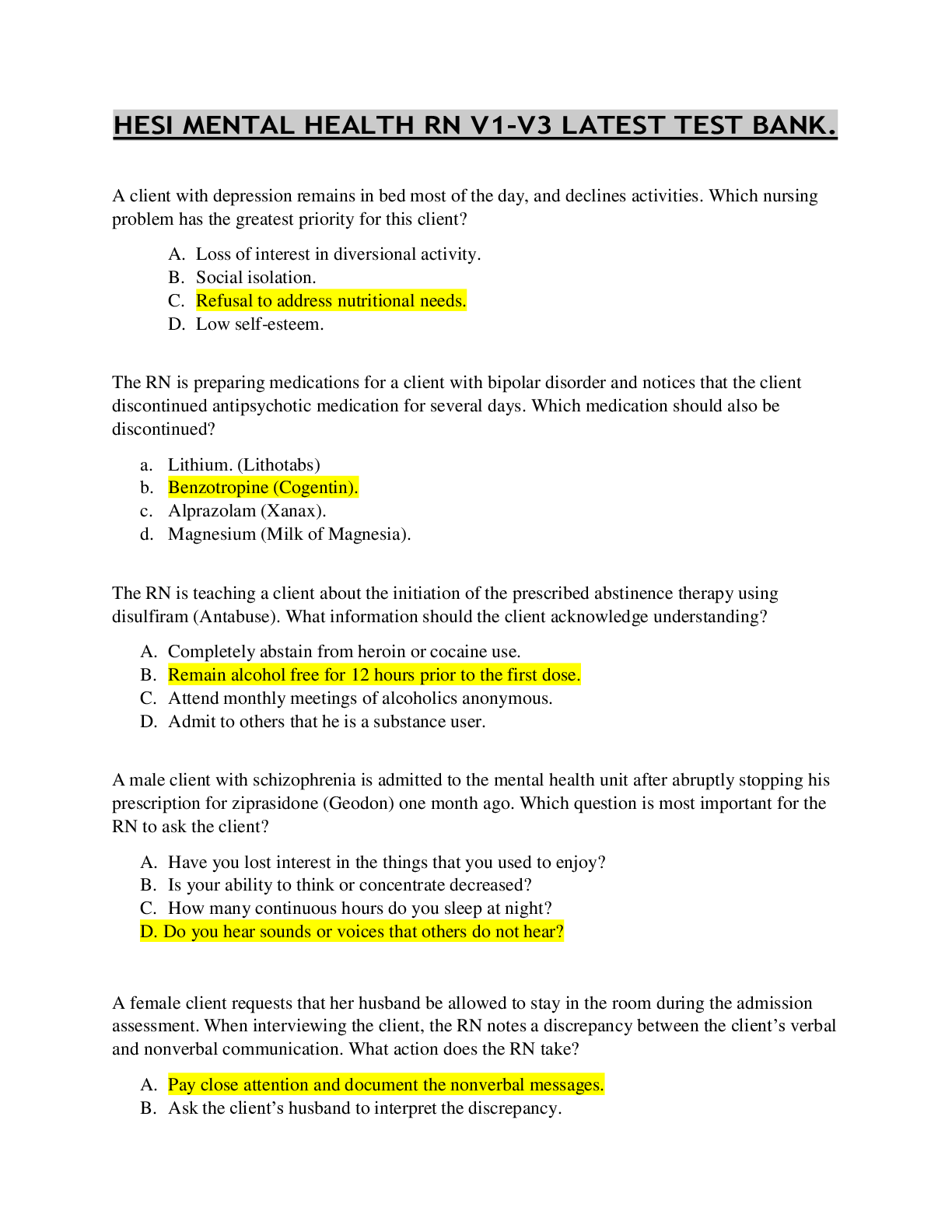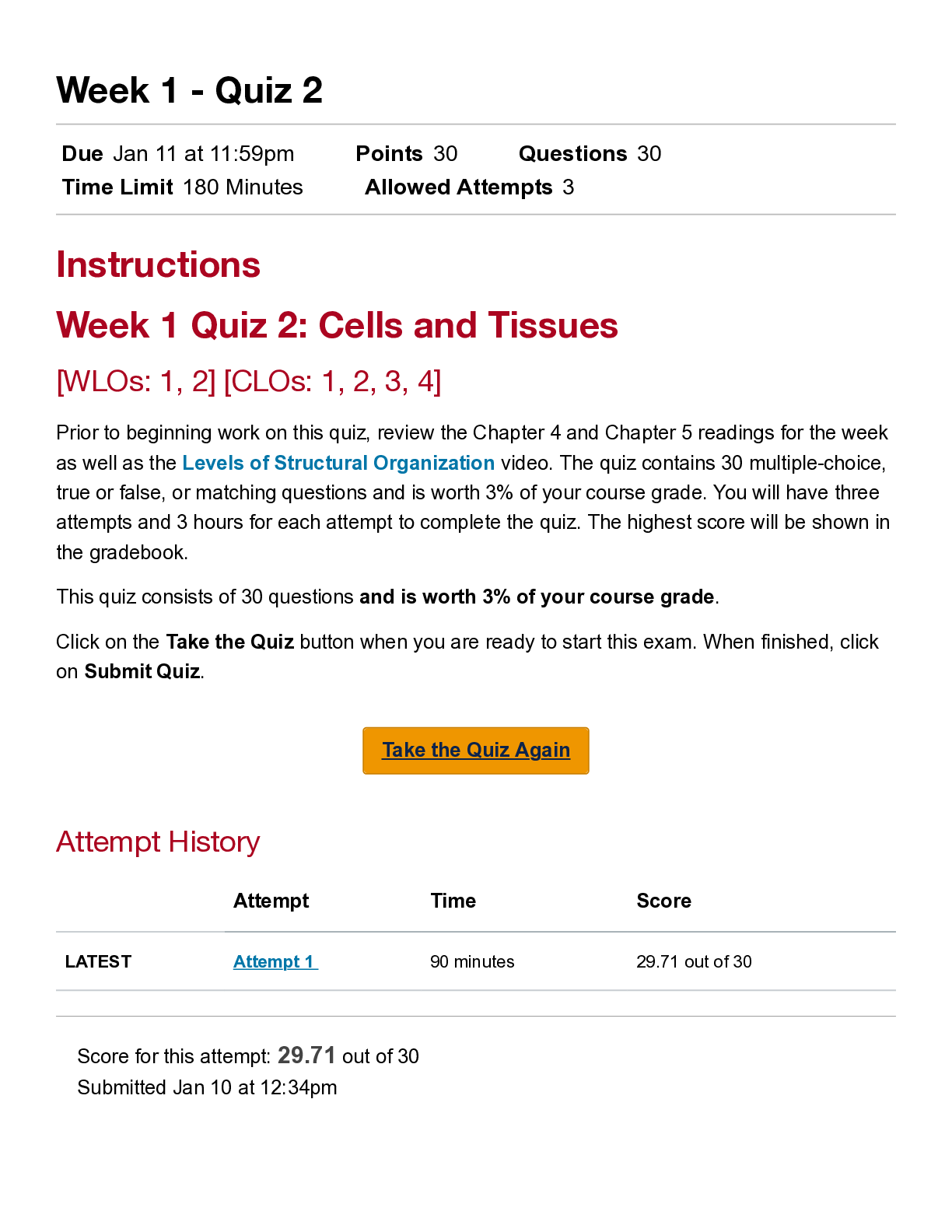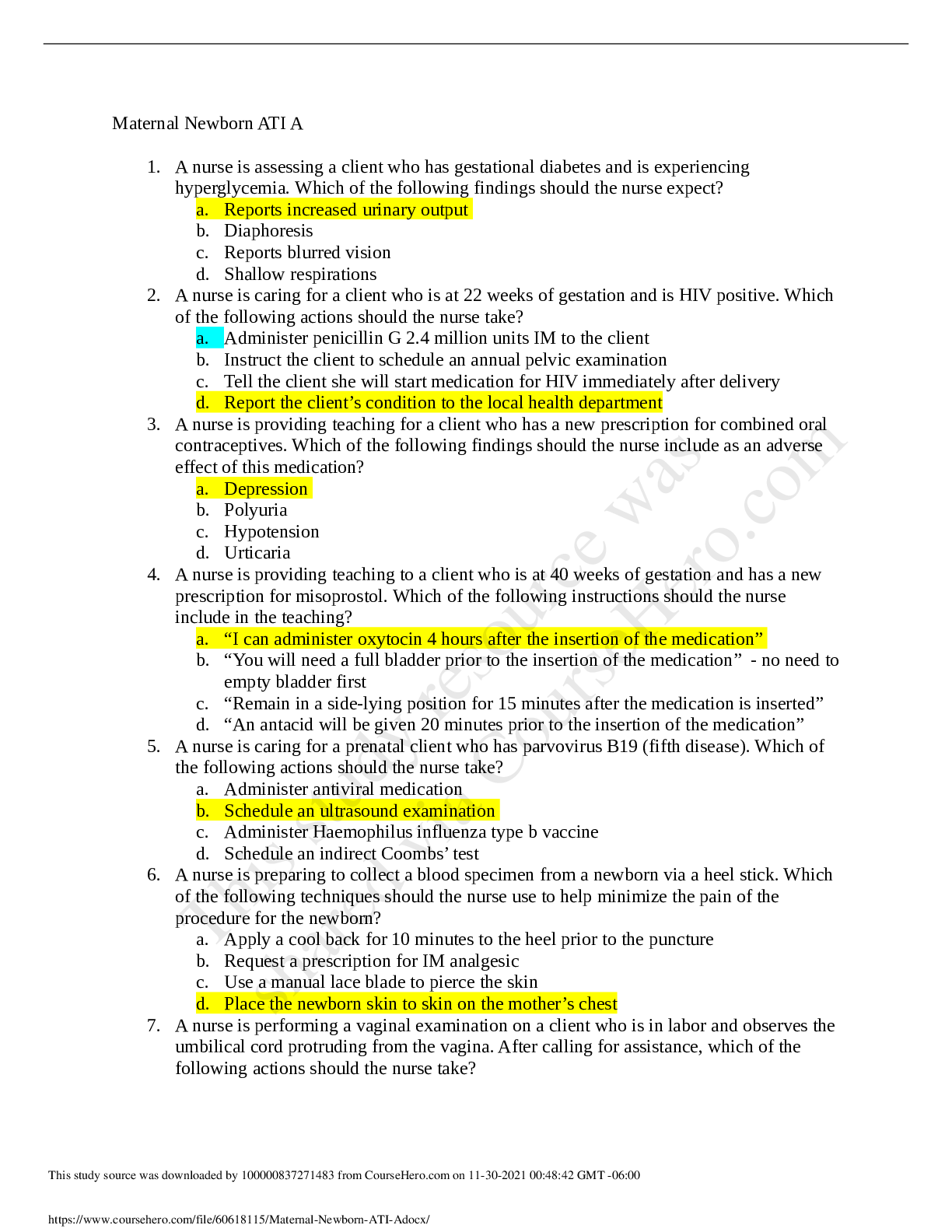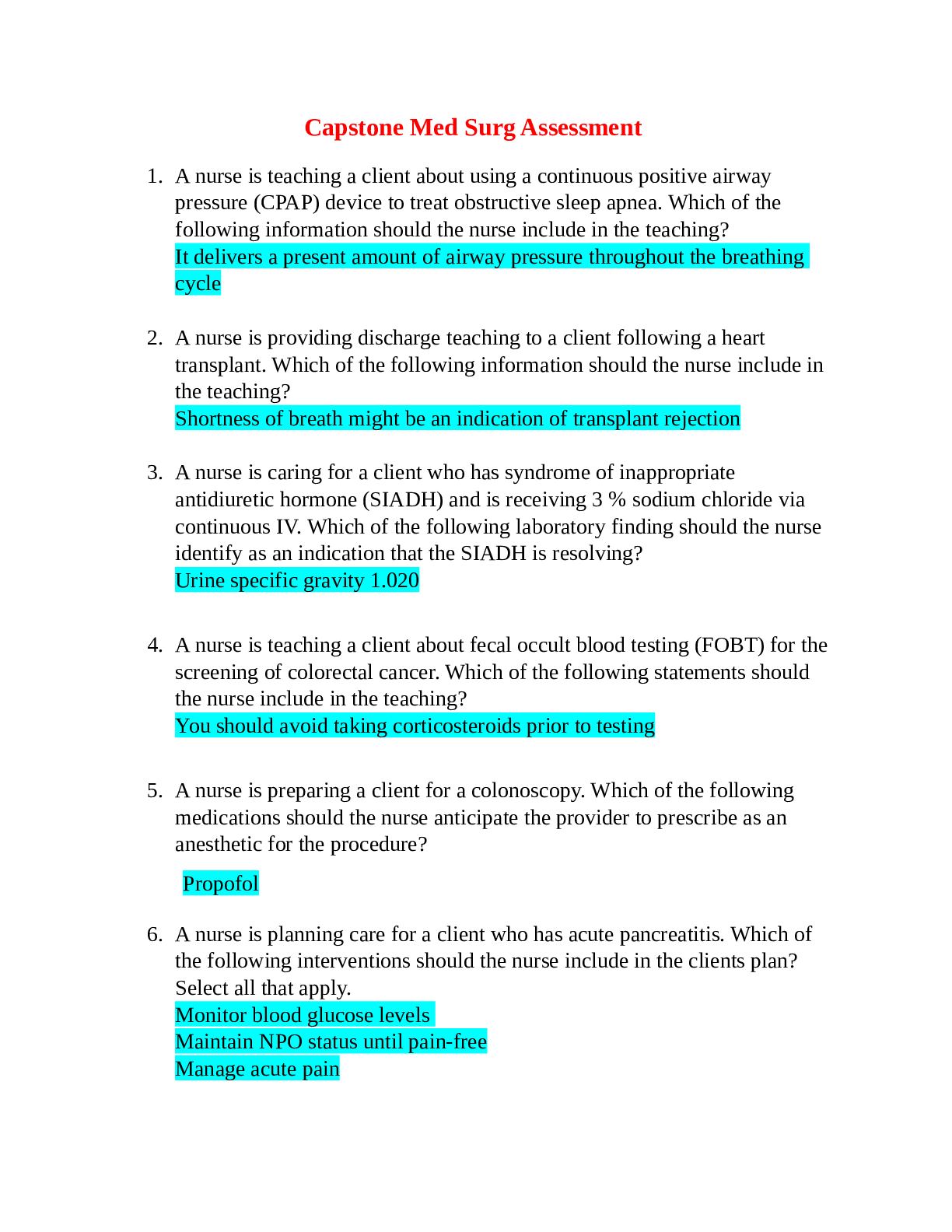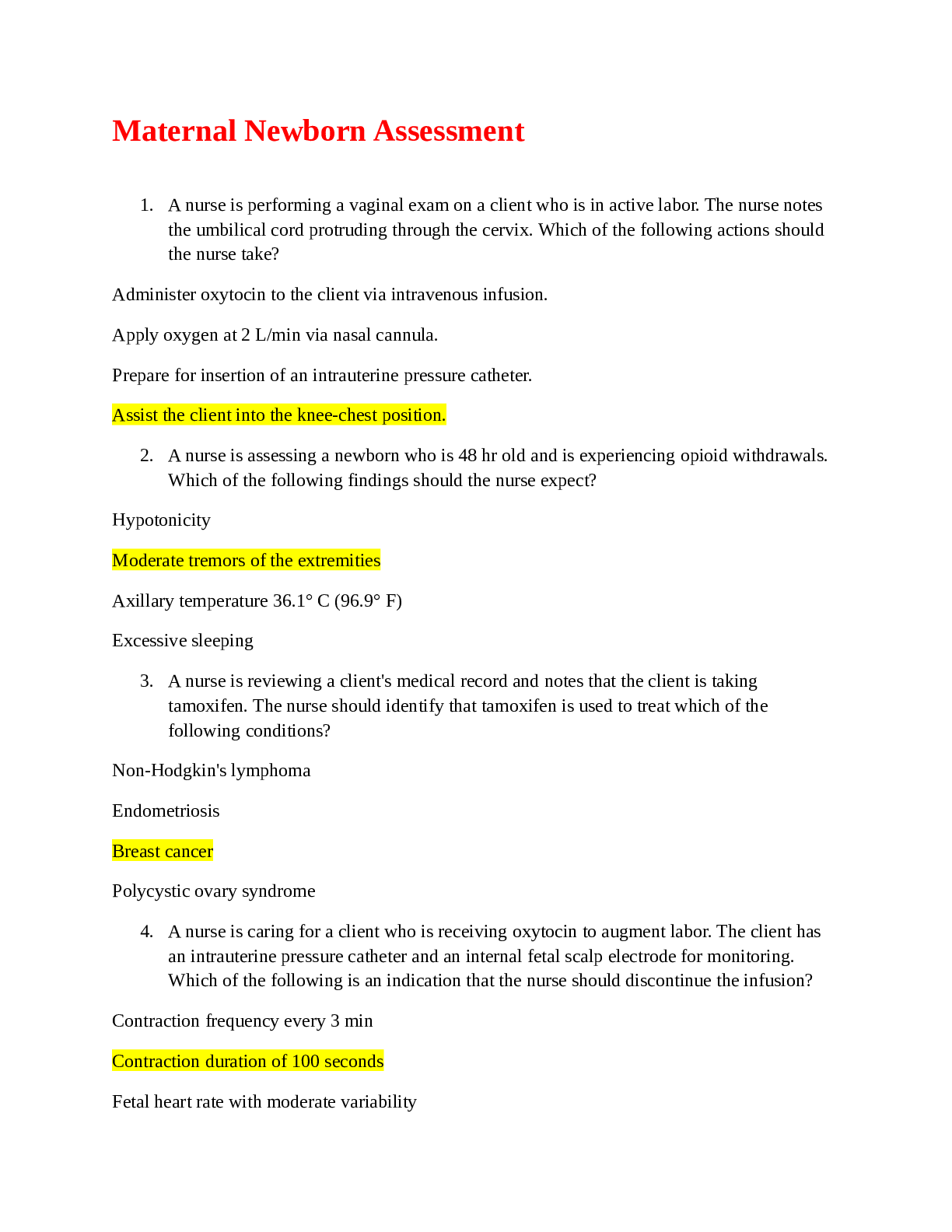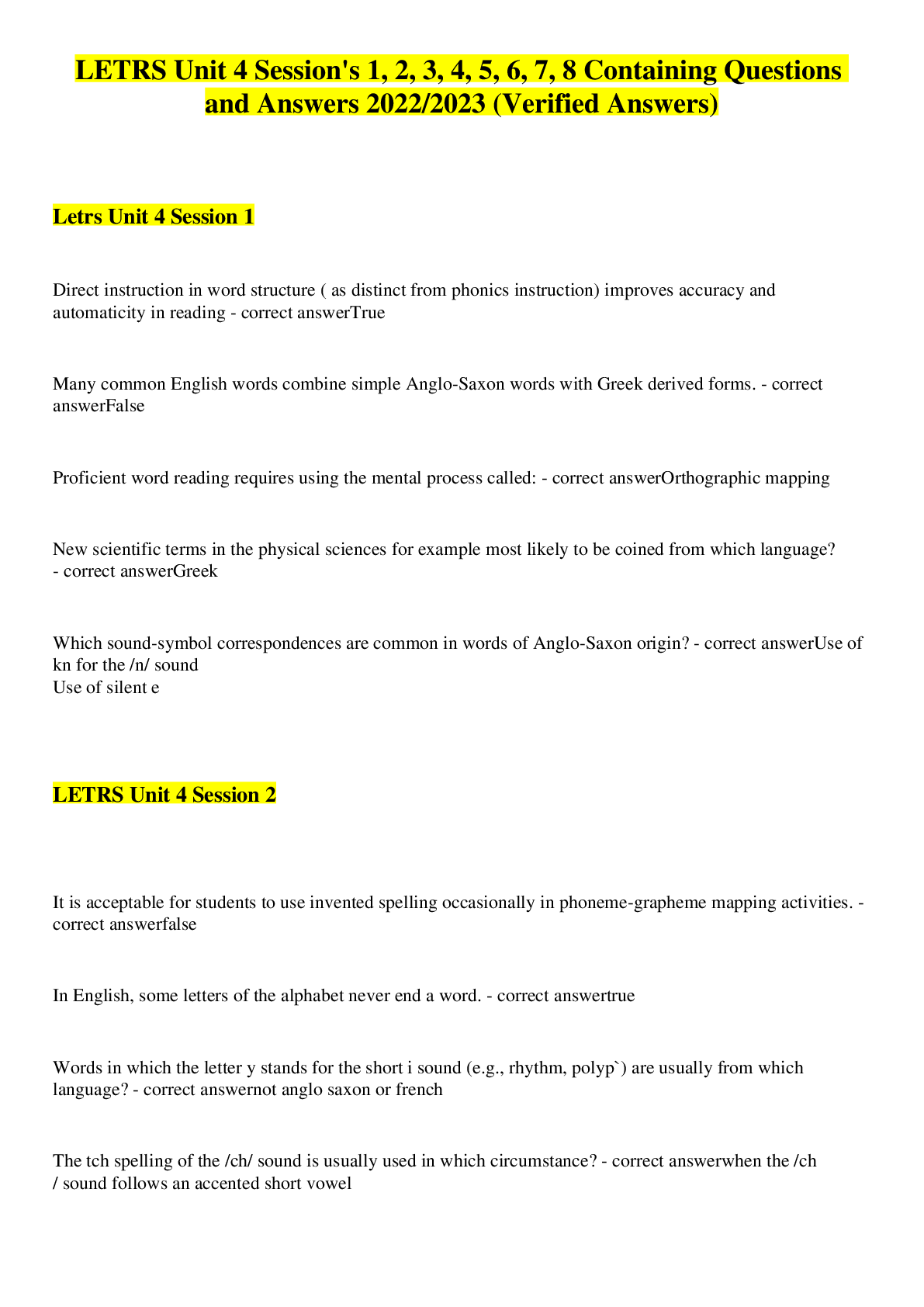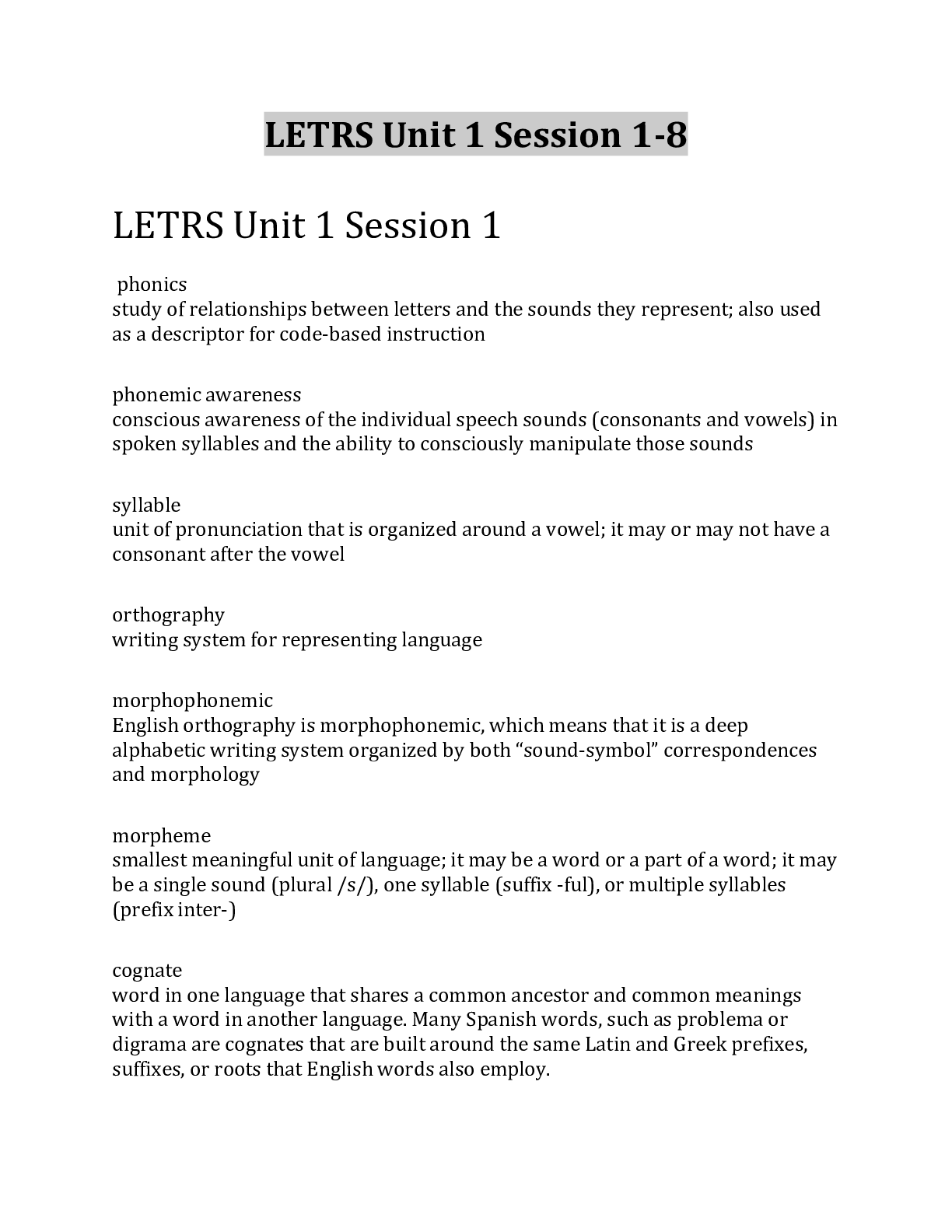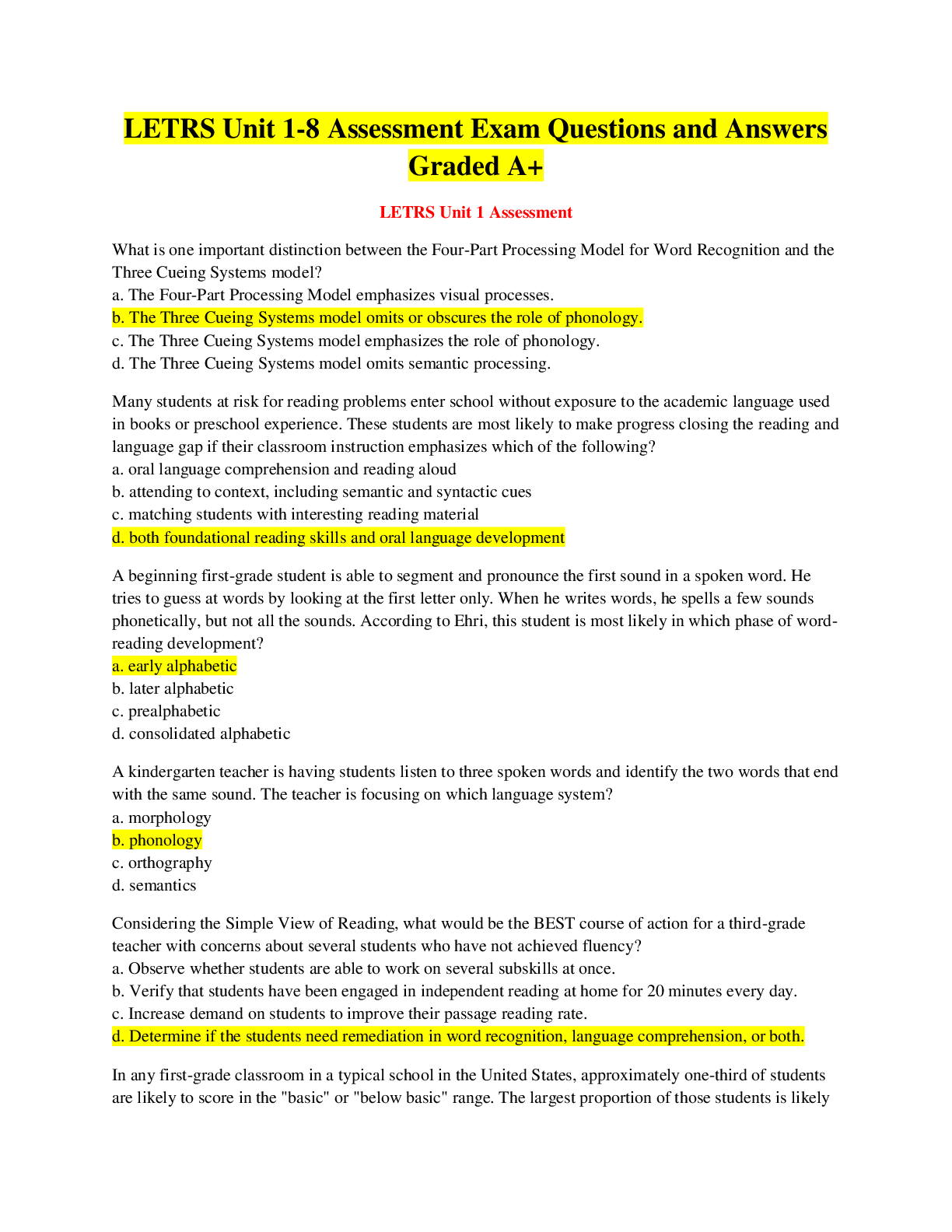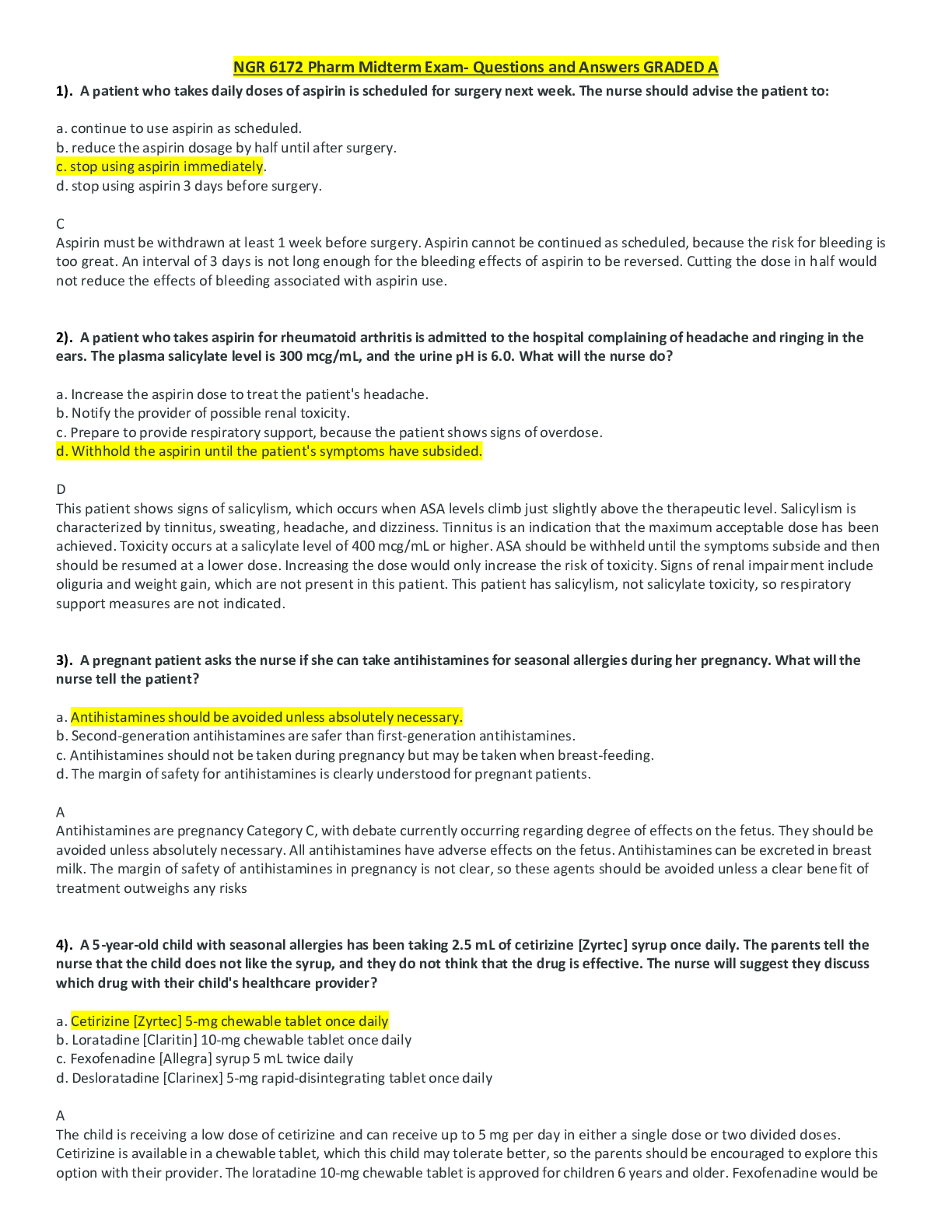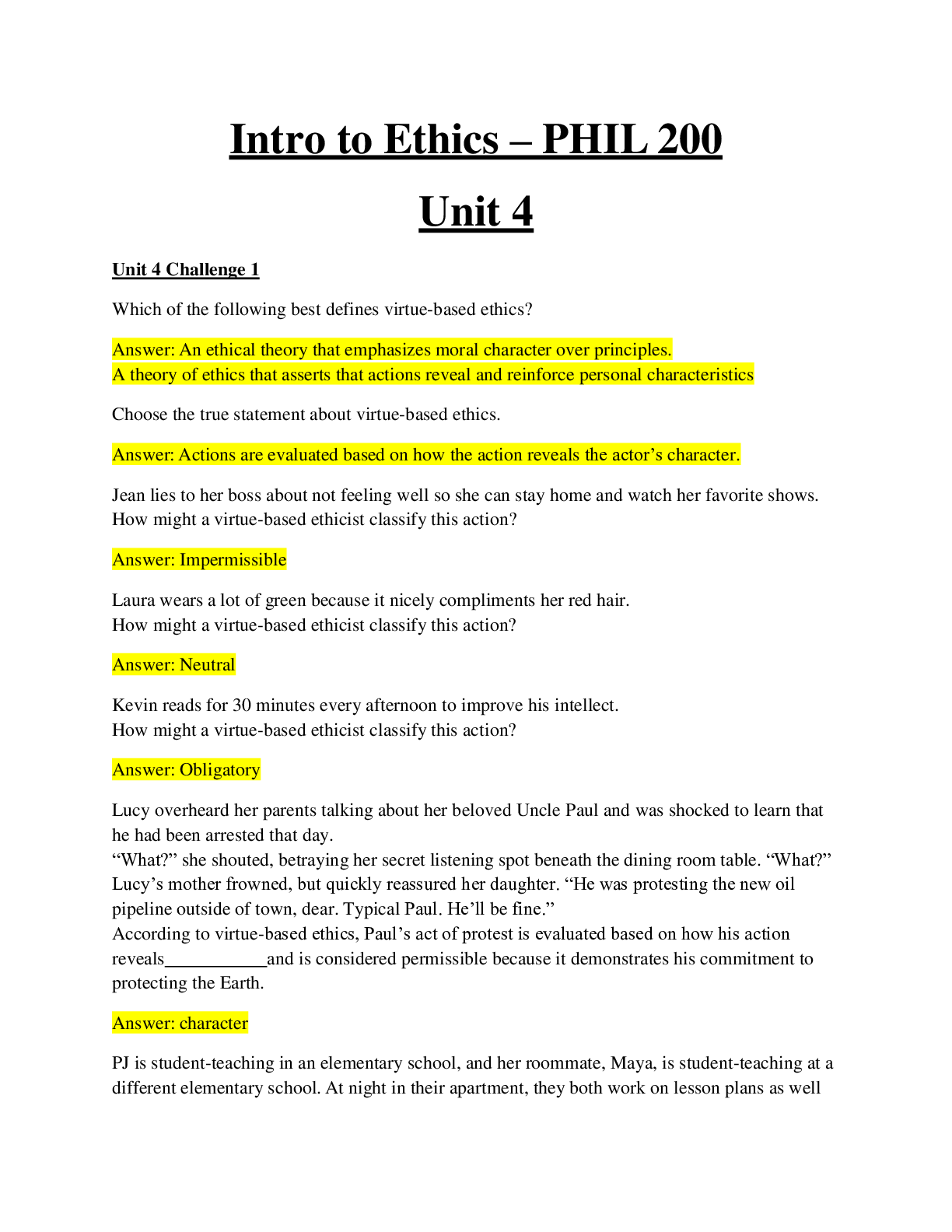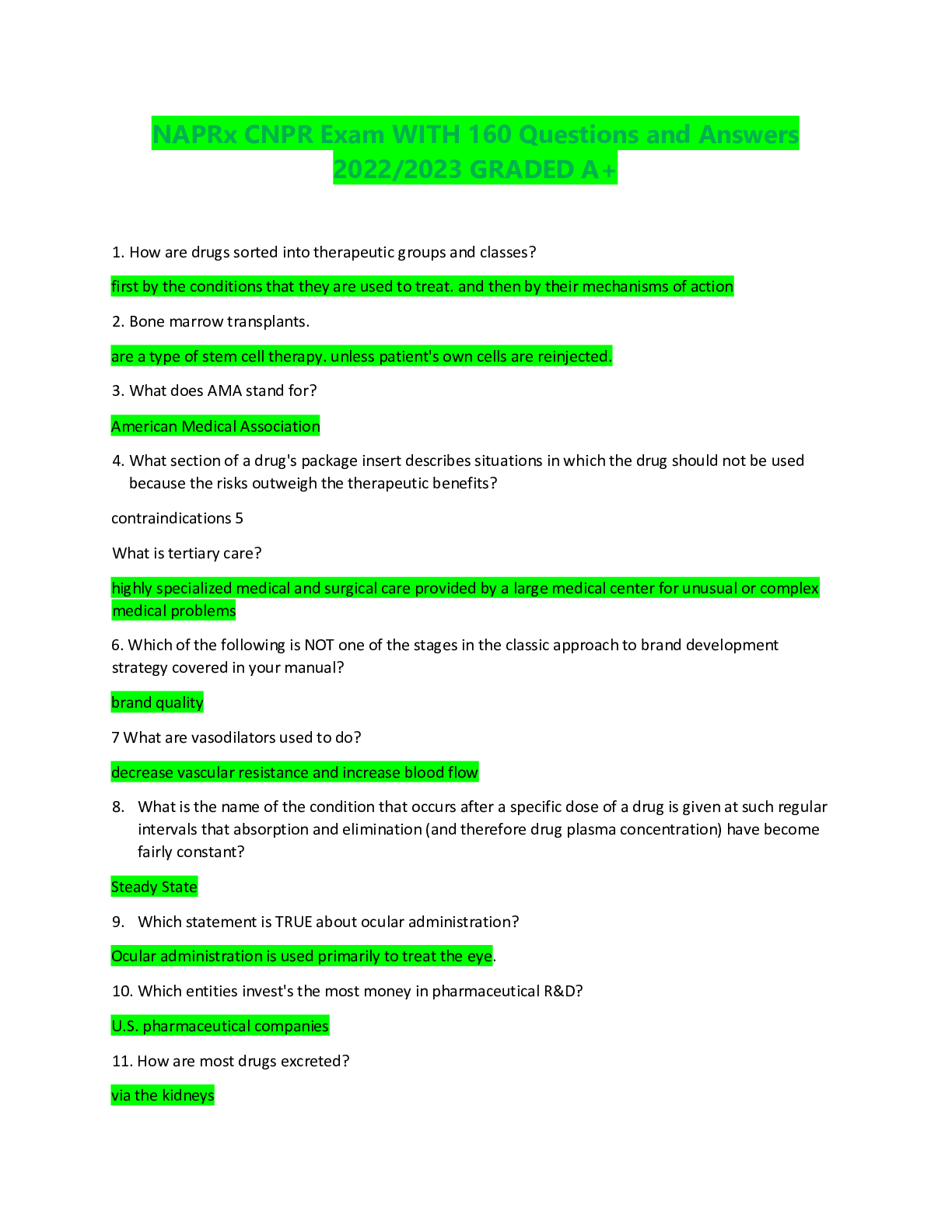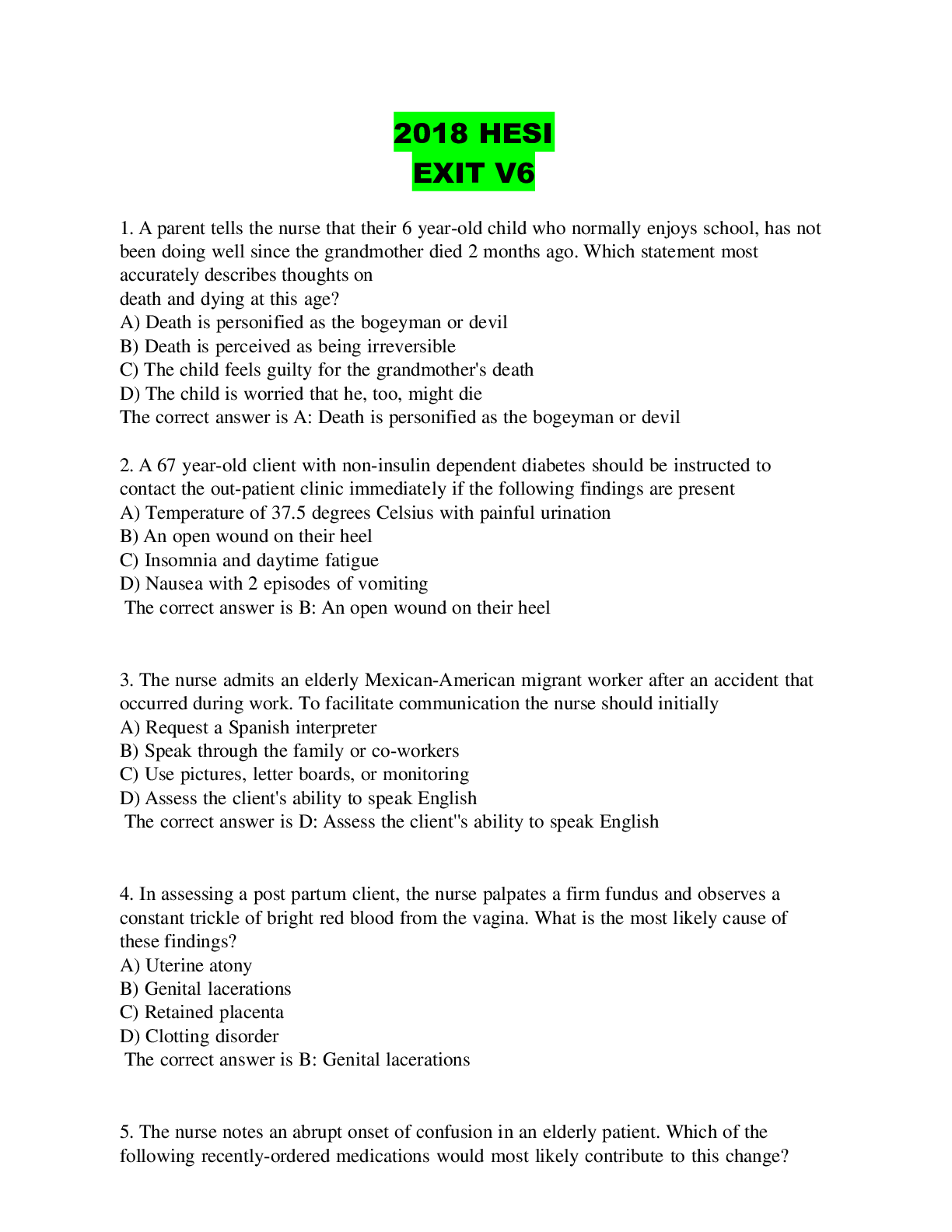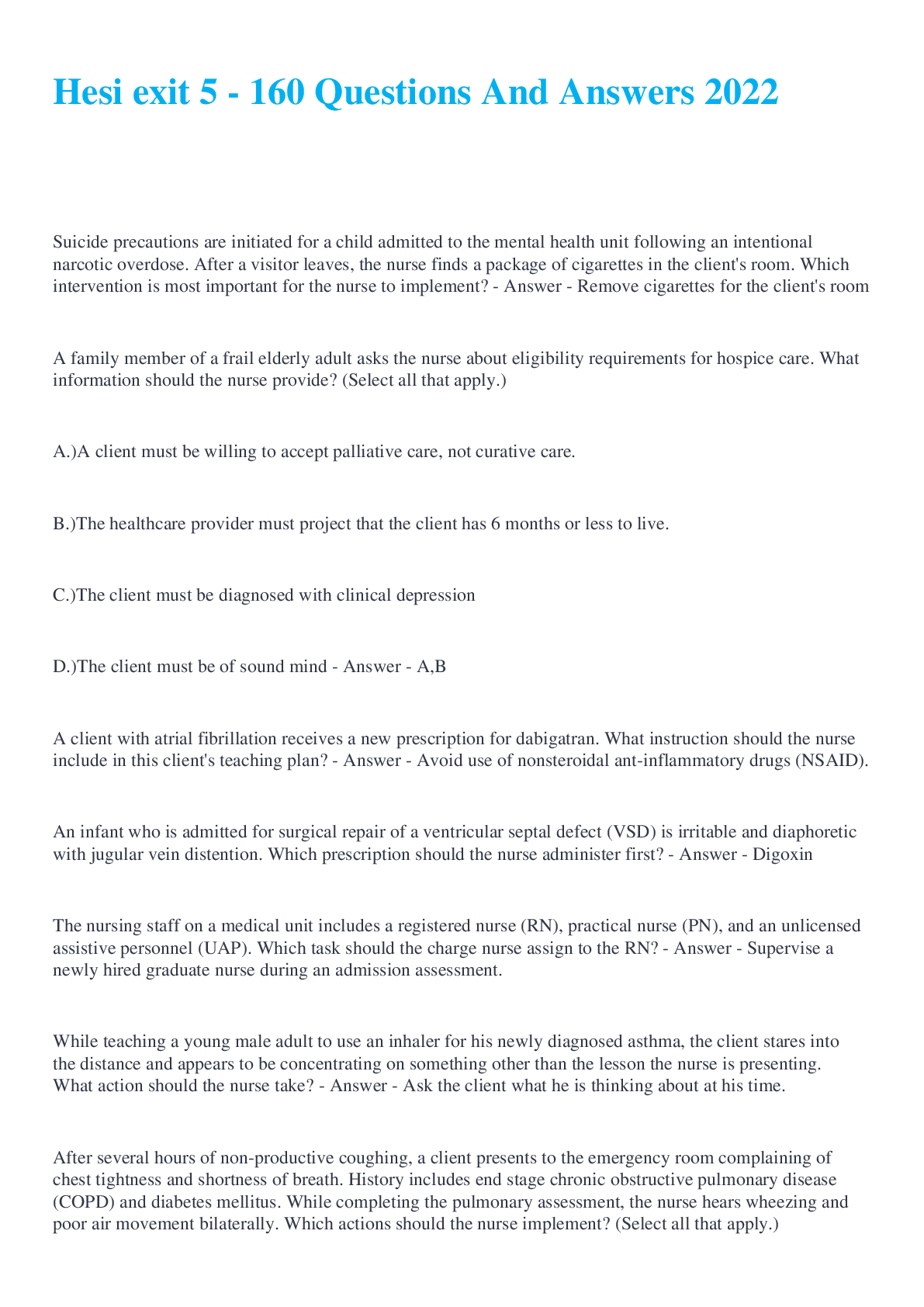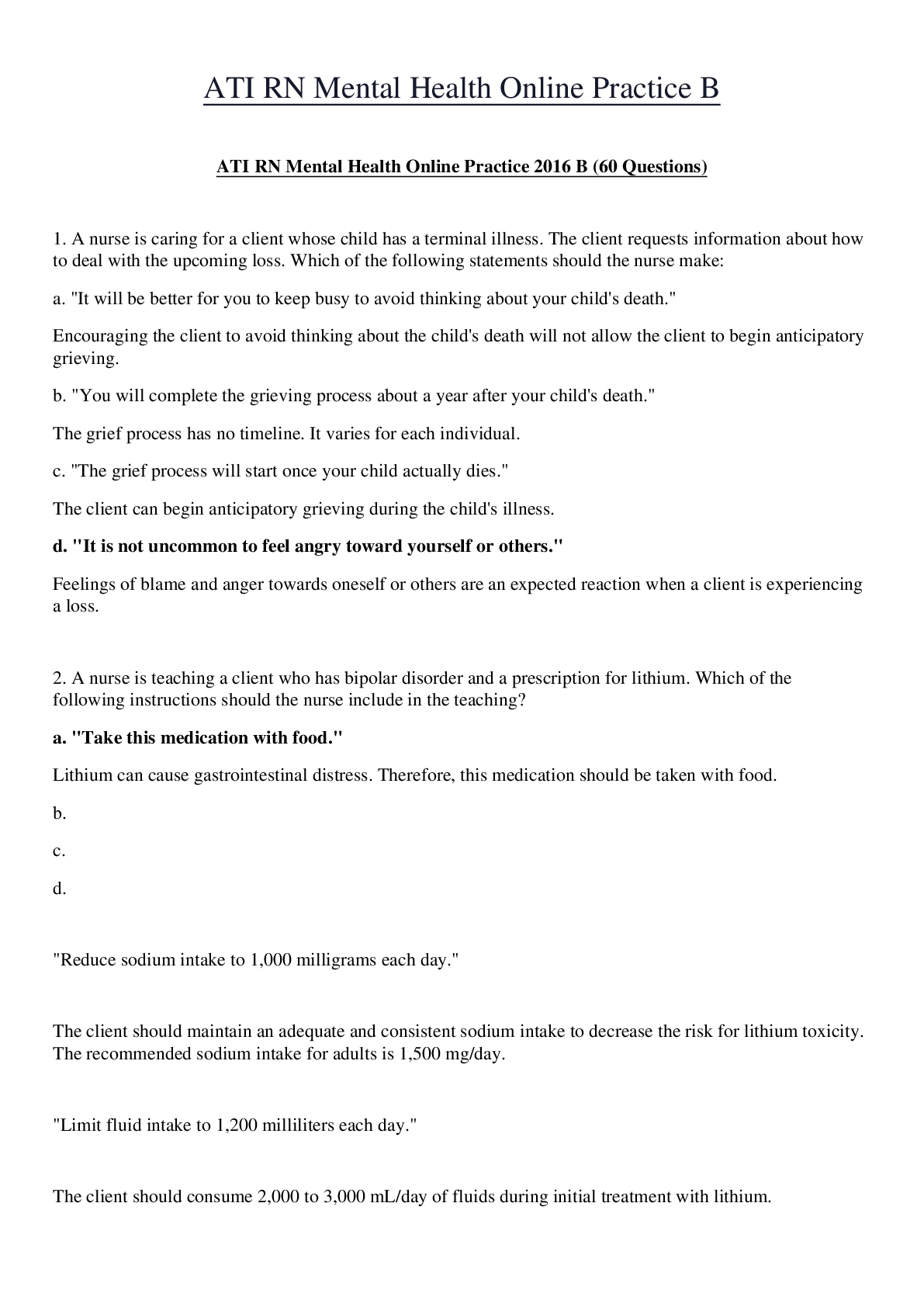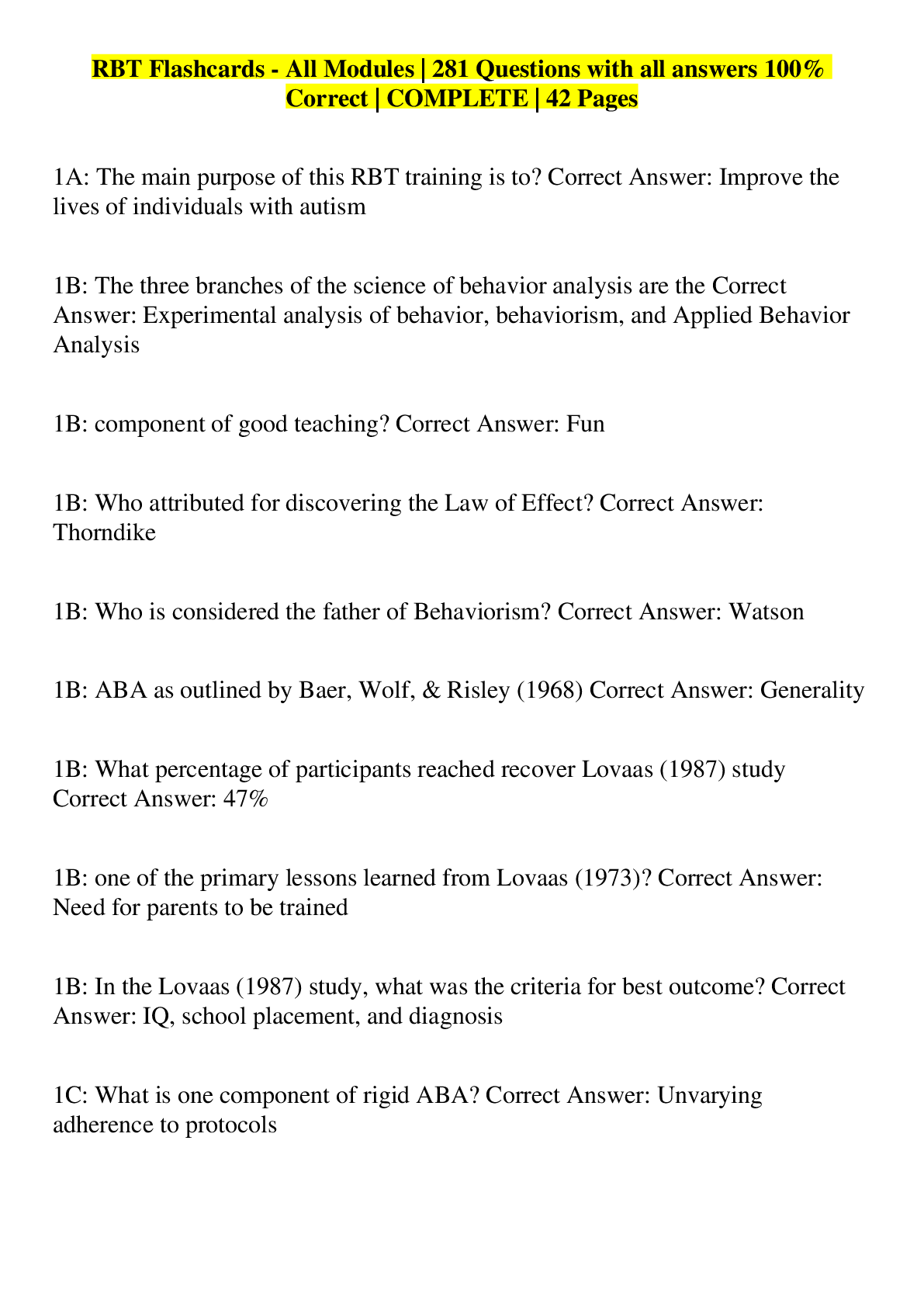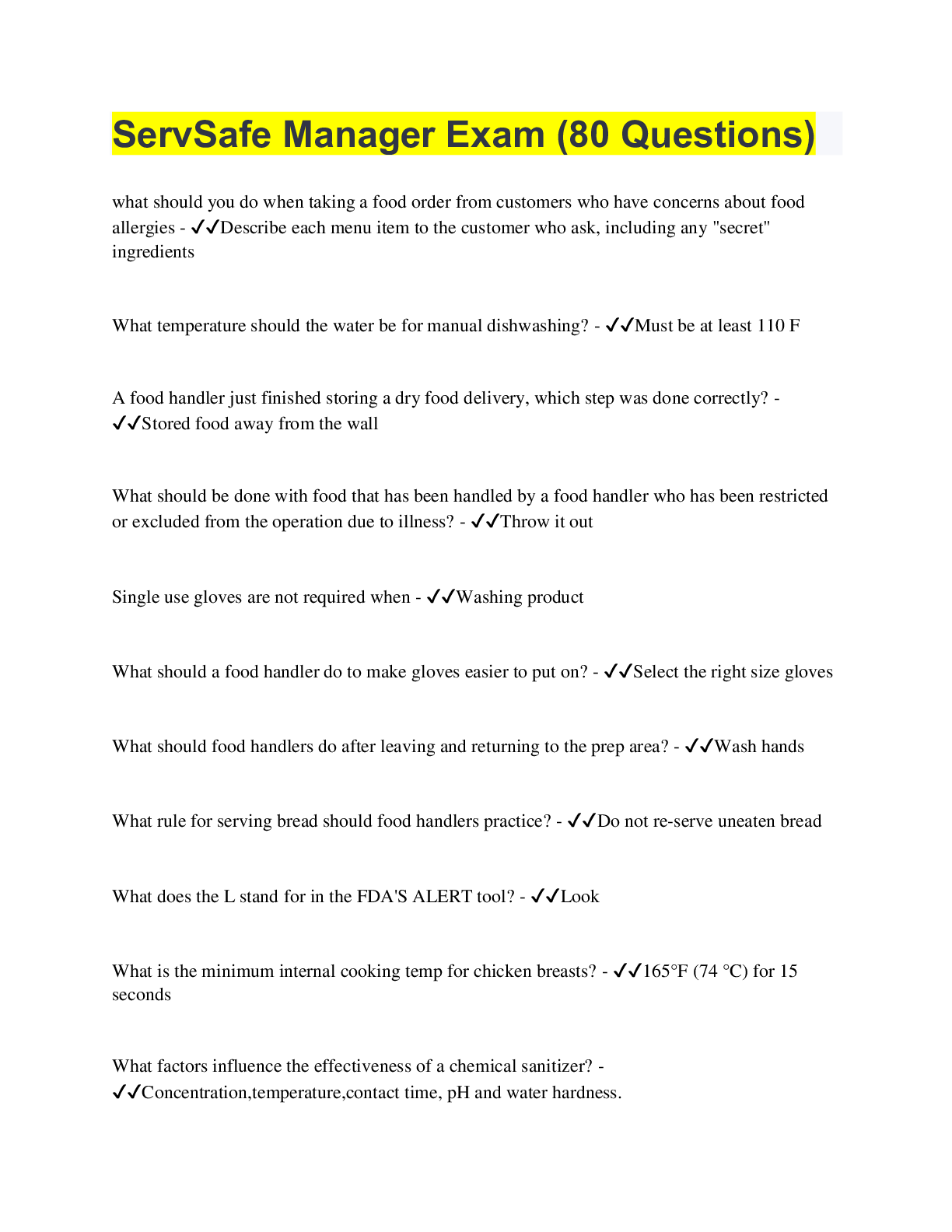Psychology > EXAM > PSYCH 160 Quiz 7 Practice Questions and Answers study guide (All)
PSYCH 160 Quiz 7 Practice Questions and Answers study guide
Document Content and Description Below
PSYCH 160 Quiz 7 Practice Questions and Answers study guide PSYCH 160 Quiz 7 Practice Questions and Answers study guide 1. Children between the ages of 6 to 11 are within the developmental called: ... a. infancy. b. early childhood. c. middle childhood. d. adolescence. 2. When comparing the rate of growth for children from ages 6 to 11, one notices that children: a. grow more slowly than they did in early childhood. b. grow faster than they did in early childhood. c. grow at the same rate from ages 2 to 12. d. have a tremendous growth spurt during the school years. 3. The health habits that children develop during the middle childhood years are: a. unrelated to their health in adolescence and adulthood. b. related to their health in adolescence, but unrelated to their health in adulthood. c. unrelated to their health in adolescence, but related to their health in adulthood. d. related to their health in adolescence and adulthood. 4. The ratio between a person's height and weight is expressed as: a. HWP. b. BMW. c. APGAR. d. BMI. 5. Which problem is often seen in obese children? a. low blood pressure b. increased psychopathology c. high levels of cholesterol d. increased chance of becoming a bully 6. Asthma is a disorder caused by ______ the airways. a. inflammation of b. enlargement of c. destruction of d. holes in 7. Better ventilation in schools and homes, less pollution, fewer antibiotics, and better medical diagnosis would be considered: a. primary prevention b. secondary prevention c. quaternary prevention d. tertiary prevention 8. An asthmatic child gets shots in the doctor's office during an asthma attack. This is a ______ level of prevention. a. primary b. secondary c. tertiary d. quaternary 9. According to Piaget, which ability do children gain during middle childhood? a. conservation b. abstract reasoning c. logic d. egocentrism 10. According to Piaget, a child between the ages of 6 and 11 can apply logical principles to: a. abstractions, such as truth and liberty. b. chemistry and physics. c. concrete and visible examples. d. questions of social justice. 11. In middle childhood, Piaget believed that children are in the period of _____ thought. a. formal operational b. preoperational c. metacognitive d. concrete operational 12. The logical principle that objects can be grouped according to some characteristic that they share is called: a. concrete thought. b. transitive inference. c. classification. d. reversibility. 13. Seven-year-old Hannah can arrange 10 buttons in order from smallest to largest. Her understanding of _____ allows her to accomplish this. a. conservation b. transitive inference c. seriation d. abstract reasoning 14. Vygotsky viewed _____ as being crucial to children's development of skills and knowledge. a. instruction b. independence c. exploration d. passive learning 15. The information-processing theory was inspired by the knowledge of how _____ function. a. animals' brains b. high-level businesses c. computers d. athletic teams 16. The time it takes for someone to respond to a particular stimulus is called _____ time. a. reaction b. response c. reflex d. relational 17. Growth in brain sophistication during middle childhood allows the child to focus on certain stimuli and exclude others. This ability is known as: a. automatization. b. decentration. c. transduction. d. selective attention. 18. _____ is one of the leading theorists of the information-processing perspective. a. Vygotsky b. Piaget c. Siegler d. Silva 19. The memory system in which signals are held for mere seconds is called _____ memory. a. pre-term b. sensory c. working d. holding 20. Which information is most likely to be in your current working memory? a. everything you see on this page b. the answer to this question c. where you saw the termworking memory in the text d. the musical theme of your favorite television show 21. By the end of middle childhood, the capacity of long-term memory is: a. limited to facts and knowledge gained through repetition. b. limited to highly emotional experiences and objective information. c. unlimited regarding information but limited about emotional experiences. d. extremely large. 22. Which factor is MOST likely to cause a child's knowledge base to increase? a. A high score on an IQ test b. past opportunities to learn c. personal motivation d. well-developed fine motor skills 23. New concepts are best learned when they are connected to: a. personal and emotional experiences. b. current events. c. a teacher-directed curriculum. d. a child-centered curriculum. 24. Children can focus without becoming distracted, persist at tasks, and exhibit quick, efficient memory due the development of: a. preoperational thought. b. reciprocity. c. the limbic system. d. control processes. 25. Evaluating a cognitive task to determine how best to accomplish and monitor one's performance is called: a. automatization. b. decentration. c. metacognition. d. social standards. 26. During middle childhood, children understand all of these aspects of language EXCEPT for: a. prefixes. b. compound words. c. phrases. d. sarcasm. 27. Abbreviations (such as LOL, BTW, and RU) in text messages and e-mails are examples of: a. metaphors. b. similes. c. grammar. d. informal code. 28. When Kitana wants her teacher to repeat a question, she asks, “Would you please repeat the question?” but when she needs a classmate to repeat himself, she says, “Huh?” This example shows that Kitana understands: a. the pragmatics of language. b. metaphors and similes. c. metacognitive processes. d. the control processes in speech. 29. Eduardo is in the fourth grade. Part of the instruction in his classroom is conducted in English and part is conducted in Spanish. His classroom uses: a. immersion. b. heritage language education. c. bilingual schooling. d. mainstreaming. 30. Jared, who speaks only English, has moved to Spain with his family. He attends a public school. All of his school subjects are taught in Spanish. Jared is learning Spanish through: a. Spanish-as-a-second-language program. b. an ESL program. c. bilingual schooling. d. immersion. 31. Approximately what percent of the world's 7-year-olds are in school? a. 45 b. 60 c. 75 d. 95 32. Jefferson High School has a student council to guarantee student representation in school affairs. Jakob, a senior, has learned that the administration of this high school wants obedience. Obedience at Jakob's school is an example of a hidden: a. agenda. b. curriculum. c. value. d. assumption. 33. The unspoken and often unrecognized lessons that children learn in school, which are the unofficial, unstated, or implicit rules and priorities that influence the academic curriculum and every other aspect of learning in school, are called the: a. territorial imperative. b. whole language theory. c. socioeconomic divide. d. hidden curriculum. 34. What is the main international test of reading given to students? a. TIMSS b. PIRLS c. WJ III d. Stanford-Binet 35. What is the primary international test of science and math given to students? a. PIRLS b. IATS c. TIMSS d. SATs 36. Which statement is true? a. Across all cultures, boys are better at math and girls are better at reading. b. In Asian countries, girls score consistently higher in math than boys. c. Academic differences between nations are much greater than differences between genders. d. In Scotland, boys average several points higher in reading than girls. 37. A federally sponsored test in the United States is the: a. TIMSS. b. NAEP. c. NCLB. d. PIRLS. 38. The Common Core is a(n) _____ that was developed with backing from all 50 states in response to doubts about state-level assessments. a. graduation exam b. law that requires frequent testing to monitor student achievement c. set of specific standards by subject and grade level d. amount of money awarded by the government for an individual child's education 39. In the United States, public schools that set their own standards, are licensed by the state, and receive funding from private money and sponsors are _____ schools. a. voucher b. private c. religious d. charter 40. One problem with smaller school class sizes is that: a. politicians won't support them. b. they are too costly. c. the research supporting their advantages is mixed. d. evidence supporting their benefits is correlational. 41. Aptitude tests are designed to measure one's: a. potential for learning. b. achievement in a particular subject. c. capacity for divergent thinking. d. verbal abilities only. 42. A person's mental age and chronological age are factors used to determine a. achievement on the WAIS. b. intelligence quotient. c. multiple intelligences. d. achievement on the WPPSI. 43. April is tested on her mastery of college chemistry. She is taking a(n): a. achievement test. b. IQ test. c. field test. d. aptitude test. 44. Achievement tests are to aptitude tests as ______ is to ______. a. long; short b. intelligence; creativity c. knowledge; potential d. fruit; apple 45. Most nations have exhibited substantial increases in IQ scores during the past century. This phenomenon is called the: a. Stanford Swell. b. Brain Leap. c. Intelligence Surge. d. Flynn Effect. 46. Howard Gardner proposed that: a. there are multiple intelligences. b. everyone is equal in all types of intelligence. c. IQ tests are the best way to measure intelligence. d. intelligence is testable. 47. IQ tests: a. reflect multicultural understanding. b. reflect the culture of the people who created the test. c. do not accurately reflect aptitude. d. accurately reflect achievement. 48. When a symptom could have multiple causes, it is known as: a. psychopathology. b. comorbidity. c. multifinality. d. equifinality. 49. Jennica experienced neglect as an infant while her mother suffered from severe depression and her father was addicted to painkillers. The outcome on Jennica's development could manifest itself in many different ways. This reflects the developmental principle of: a. psychopathology. b. comorbidity c. multifinality. d. equifinality. 50. Approximately what percentage of young children have attention-deficit/hyperactivity disorder? a. 10 percent b. 20 percent c. 30 percent d. 40 percent 51. Children with attention-deficit/hyperactivity disorder: a. are always impulsive. b. are always objective. c. can concentrate momentarily. d. struggle to pay attention. 52. Ten-year-old Wilson experiences extreme mood swings that do not seem to be influenced by life circumstances. At times he has told his parents that his teachers are idiots and he is smarter than all of them, and at other times he has so little energy he cannot get out of bed. Wilson may be diagnosed with: a. autism spectrum disorder. b. bipolar disorder. c. childhood schizophrenia. d. attention-deficit hyperactivity disorder. 53. Seven-year-old Henry has been diagnosed with both ADHD and bipolar disorder. Which term applies to Henry having both conditions? a. conflicting diagnoses b. complex diagnosis c. comorbidity d. coexistence 54. Distinguishing between a diagnosis of ADHD and bipolar disorder in children is challenging. _______ is a new diagnosis, added in the DSM-5, that helps to resolve this confusion. a. Disruptive mood dysregulation disorder b. Comorbidity c. Autism spectrum disorder d. Specific learning disorder 55. Research has found that appropriately medicated children with ADHD are: a. more likely to abuse drugs in adolescence than their nonmedicated peers with ADHD. b. less likely to abuse drugs in adolescence than their nonmedicated peers with ADHD. c. more likely to suffer from stunted growth than their nonmedicated peers with ADHD. d. actually suffering from bipolar disorder. 56. Many psychoactive drugs are prescribed to children to treat depression without being thoroughly tested on children. Therefore, the use of these drugs for children is referred to as: a. psychotherapy. b. psychostimulating. c. off-label. d. inappropriate. 57. Which learning disability is characterized by unusual difficulty with reading? a. developmental dyslexia b. ADHD c. autism d. bipolar disorder 58. What is the term for a specific learning disability related to math? a. dyslexia b. dyscalculia c. ADHD d. autism spectrum disorder 59. Children with any form of autism spectrum disorder have: a. difficulty speaking. b. a lack of eye contact. c. difficulty understanding others' speech. d. difficulty understanding emotions. 60. About 1 out of every 100 children in the United States have this developmental disorder. a. dyscalculia b. mental retardation c. autism spectrum disorder d. disruptive mood dysregulation disorder 61. A document for children with special needs that specifies their educational goals is known as a(n): a. IEP. b. IFSP. c. LRE. d. RTI. [Show More]
Last updated: 1 year ago
Preview 1 out of 10 pages
.png)
Reviews( 0 )
Document information
Connected school, study & course
About the document
Uploaded On
Dec 17, 2020
Number of pages
10
Written in
Additional information
This document has been written for:
Uploaded
Dec 17, 2020
Downloads
0
Views
36

